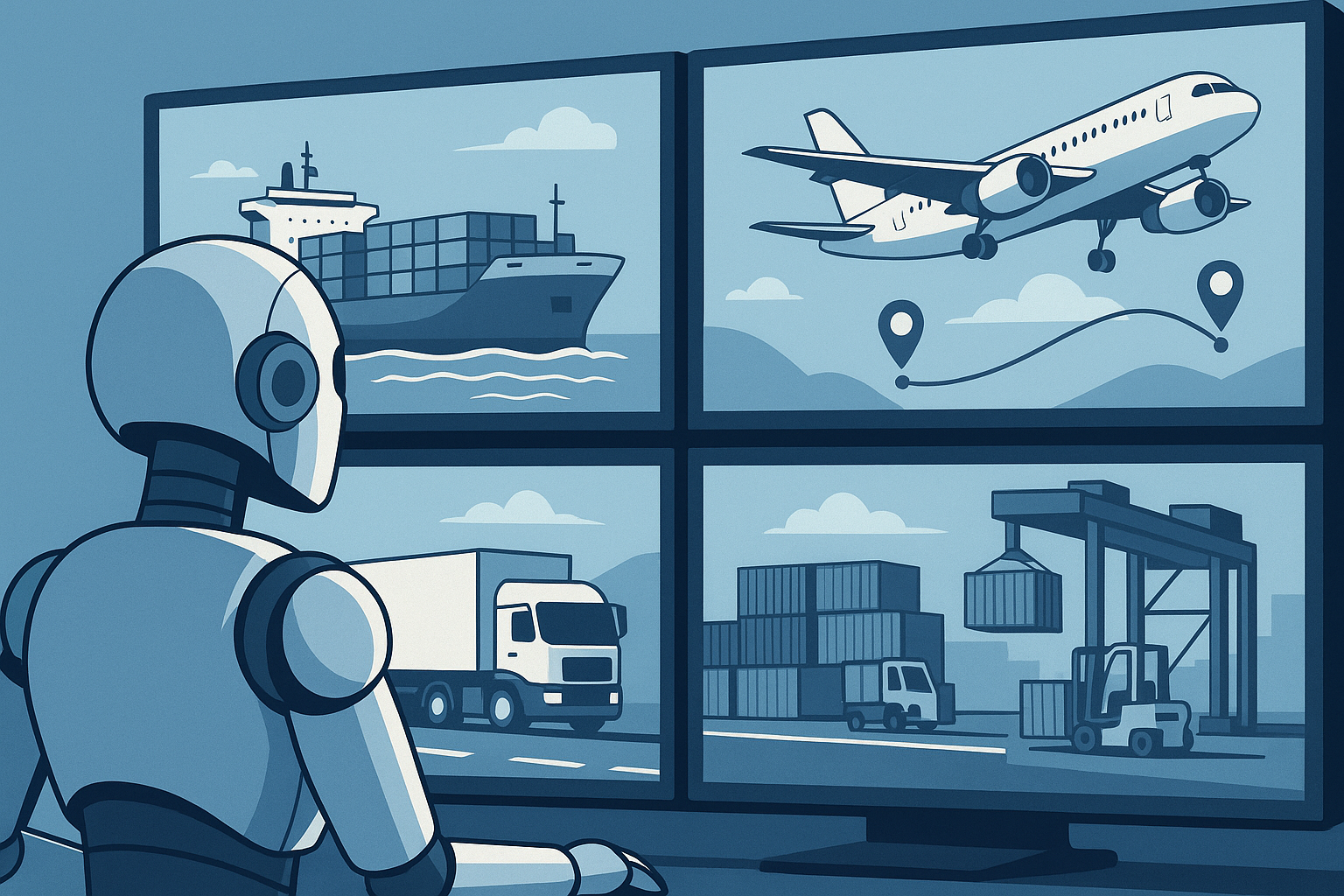Logistics has always been the step ahead—centuries before e-commerce, supply chains used clever tricks to outpace uncertainty. Now, machine learning has taken that legacy to new heights. Today’s logistics providers are pioneering AI-driven forecasting that many other industries are only beginning to explore.
The stakes are high. In 2025, the global AI in logistics market is projected to reach $26.3 billion, growing at an annual rate of 46%. Over 65% of logistics companies are already using AI-powered solutions to optimize operations, with 93% of LTL and fleet operators believing AI boosts resilience and adaptability. Cutting-edge tools link weather, traffic, supplier data, and real-time sensor output to preempt disruptions—before they unravel deliveries.
Why logistics? These companies operate on razor-thin margins and tight schedules. The slightest delay—a storm at a port, a breakdown mid-route—can ripple across the system. Predicting these problems isn’t a luxury, it’s essential.
That’s where Machine Learning (ML) enters. Unlike traditional systems that rely on lagging indicators and manual intervention, modern predictive models detect subtle patterns early—whether it’s a truck’s vibration spike, a shift in port congestion, or a supplier’s delay trend.
Why Traditional Methods Fail
For decades, logistics relied on a familiar mix of human intuition, fixed schedules, and historical averages. Dispatchers knew the roads. Managers remembered seasonal delays. Spreadsheets tracked shipments, and buffers were added “just in case.” It worked—until it didn’t.
Modern logistics is faster, more global, and far less forgiving. A factory delay in Vietnam, a border check in Slovakia, or a thunderstorm in Istanbul can derail a delivery chain that spans continents. What was once a manageable risk now spirals quickly into costly disruption.
The problem isn’t just scale. It’s complexity. Traditional systems weren’t built to process real-time sensor data, weather patterns, supplier performance, or geopolitical risk feeds. At best, they react. At worst, they guess.
Forecasting delays based on last month’s averages? Irrelevant if a port shuts down tonight. Relying on fixed route preferences? Inefficient when traffic data suggests an alternative. Human planners can’t evaluate dozens of variables across thousands of routes every minute.
That’s where legacy methods hit their limit. They’re static in a dynamic environment, slow in a world that demands real-time decisions.
Machine learning doesn’t replace logistics experience—it amplifies it. But first, it exposes the blind spots in systems that were never designed to see ahead.
Enter Machine Learning: The Predictive Layer
If traditional logistics systems answer “what happened?”, machine learning answers “what’s about to happen?” That shift—from reactive to predictive—is exactly what the modern supply chain needs.
Machine learning models excel at recognizing subtle patterns across vast, messy datasets. They’re trained not just on shipment times and delivery logs, but on live weather feeds, GPS data, port congestion stats, carrier reliability scores, maintenance logs, and even global news. Once trained, they can detect risk signals long before human planners even sense a problem.
Consider a route from Warsaw to Rotterdam. A traditional TMS (transport management system) might choose the shortest or cheapest option based on historical norms. A machine learning model might spot something else: an unexpected spike in congestion near the German border, weather delays approaching the Ruhr, and a rising number of late deliveries from a particular subcontractor. The system reroutes automatically—no drama, no disruption.
ML models can also learn from non-obvious correlations. A specific supplier’s delay rate might increase when port container density crosses a certain threshold. A warehouse’s average outbound time might rise when humidity exceeds a certain level—which could indicate equipment slowdowns or staff inefficiency. These patterns wouldn’t stand out to a human planner. But to an algorithm trained on millions of rows of data, they’re obvious.
This is the predictive layer modern logistics companies are adding on top of legacy systems. It doesn’t replace ERP or TMS platforms—it augments them. It flags risks, suggests alternatives, recalculates in real time.
The result? Shipments don’t just move—they anticipate. And that alone can save millions in lost time, rush fees, and customer churn.
Key ML Use Cases in Disruption Detection
Machine learning isn’t a black box—it’s a toolkit. And in logistics, it’s already being used to solve problems that were once considered unavoidable. Below are the most practical, high-impact applications where ML is quietly transforming disruption management.
Delay Prediction Models
ML models trained on historical and real-time data can predict delivery delays before they happen. These models account for variables like route history, weather, carrier behavior, time of day, and even geopolitical conditions.
Example:
A multinational freight forwarder reduced ETA variance by 40% using ML models that re-estimate delivery windows every 15 minutes based on live conditions. Instead of apologizing for delays, they prevent them.
Risk-Based Supplier Scoring
Traditional supplier evaluations rely on past performance. ML takes it further, constantly recalculating risk scores based on shipping delays, complaint rates, pricing anomalies, or even news sentiment from public sources.
Example:
A European automotive manufacturer integrated a dynamic supplier risk model that flagged a key component vendor two weeks before a bankruptcy filing — giving procurement time to activate backups.
Dynamic Route Optimization and Re-Routing
Instead of relying on fixed “best routes,” ML suggests real-time adjustments. It factors in traffic patterns, delivery urgency, toll costs, historical delay zones, and fuel efficiency for each vehicle type.
Example:
An urban logistics company improved on-time deliveries by 22% by deploying an ML-based routing engine that re-optimizes routes every 30 minutes.
Inventory Adjustment and Pre-Positioning
ML models predict when and where inventory should be moved—before demand spikes or supply gets disrupted. This is especially useful in last-mile and seasonal logistics.
Example:
An e-commerce fulfillment center avoided a 4-day shipping delay during peak season by using ML to reposition high-risk SKUs in advance, based on pattern recognition from previous years.
Predictive Maintenance for Fleet & Equipment
Sensor data from trucks, cranes, and sorters is analyzed using ML to detect early signs of mechanical failure. This reduces unexpected downtime and extends asset life.
Example:
A freight carrier reduced breakdowns by 30% using ML-driven vibration and heat sensor analytics, flagging anomalies days before failure.
These are not moonshot applications. They’re running today, often quietly, inside dashboards and back-end systems. The logistics companies seeing the biggest gains are not those with the biggest budgets—but those with the cleanest data and the courage to hand some decisions over to the machine.
Benefits Beyond Prediction
Machine learning doesn’t just predict delays—it reshapes how logistics companies operate, plan, and deliver. When disruptions are anticipated early, the entire supply chain becomes more resilient, not just faster.
1. More Accurate ETAs = Fewer Broken Promises
Improved delivery time estimates reduce customer service load, missed SLAs, and refund costs. In B2B logistics, that precision builds trust. In B2C, it prevents churn. It also allows sales teams to commit with confidence—not just hope.
2. Lower Operational Costs
Every surprise avoided is a cost saved:
- No need for emergency shipments
- Less fuel spent on inefficient rerouting
- Fewer penalties for late arrivals
- Reduced labor hours spent firefighting
A 2023 study by McKinsey estimated that AI-driven forecasting can reduce overall supply chain costs by up to 15% when applied correctly.
3. Real-Time Visibility, Cross-Team Alignment
When ML systems flag risks early, operations, finance, and procurement teams can all respond in sync. No more last-minute emails or war rooms. Delays become scenarios to manage, not disasters to fix.
4. Proactive Rather Than Reactive Culture
Perhaps the biggest benefit isn’t technical at all—it’s psychological. When a company moves from reacting to predicting, decision-making becomes calmer, clearer, and more strategic. Teams begin to ask “what’s likely?” instead of “what went wrong?”
5. Scalable Advantage
ML models improve with use. The more data you feed them, the better they get. Over time, companies with predictive infrastructure outperform those who still rely on yesterday’s reports to make tomorrow’s decisions.
Disruptions will never disappear. But the difference between a setback and a crisis often comes down to whether you saw it coming.
Implementation Challenges
Machine learning in logistics is powerful—but not plug-and-play. Many companies underestimate what it takes to move from interest to impact. The technology works. The question is whether the organization is ready.
Data Fragmentation
ML models are only as good as the data they learn from. But in most logistics operations, data lives in silos:
- Shipment logs in one system
- Inventory in another
- Traffic data via third-party APIs
- Driver performance in paper logs
Bringing these sources together is a technical and political challenge—one that often slows implementation more than the algorithms themselves.
Dirty Data, Wrong Signals
Old systems often contain missing values, duplicate entries, outdated formats, and mislabeled categories. Feeding this into an ML model leads to garbage predictions—or worse, dangerously confident ones.
Before any AI rollout, companies must invest in data cleansing, governance, and normalization. It’s the unglamorous work behind every “intelligent” solution.
Lack of In-House Expertise
Logistics firms know routes, not regression models. And while off-the-shelf ML tools exist, customizing them to specific operational contexts still requires skilled data scientists and ML engineers—not to mention translators who can bridge business and technical teams.
Organizational Resistance
Dispatchers may distrust algorithmic suggestions. Managers may fear automation. IT may push back on integrating yet another layer. And leadership might hesitate to fund something that doesn’t guarantee immediate ROI.
Without internal alignment, ML adoption stalls—not because the models fail, but because the people around them never bought in.
Legacy Systems Don’t Like to Talk
ERP platforms built in the 2000s aren’t made for real-time data exchange. Integrating ML into aging infrastructure often involves extensive middleware, custom APIs, or painful manual workarounds.
These challenges aren’t deal-breakers—but they are real. The companies succeeding with ML in logistics didn’t start with a flashy algorithm. They started with an honest look at their data, systems, and readiness to change.
What’s Next: From Forecasting to Autonomous Response
Prediction is only the beginning. The real value of machine learning in logistics lies not just in knowing what will happen — but in acting on it instantly, at scale, and without human bottlenecks.
This is where the industry is headed: from predictive to autonomous systems. Where once an ML model would alert a dispatcher to a likely delay, now it can also recalculate the route, reallocate the inventory, or reschedule a delivery window—all automatically.
Table: Key Capabilities Enabling Autonomous Logistics Response
| Capability | Description |
|---|---|
| Autonomous Dispatching & Routing | Automatically recalculates delivery schedules in real time, adapting to traffic, costs, and delays without human input. |
| Self-Correcting Warehousing | Triggers micro-fulfillment, pre-picking, or dynamic stock relocation in response to predicted inventory disruptions. |
| Closed-Loop Feedback Systems | Uses model outputs to improve future predictions through continuous data feedback and model tuning. |
| Human + Machine Collaboration | Machines handle the repetition; humans handle strategy. ML becomes a co-pilot, not a replacement. |
| Real-Time Orchestration at Scale | Connected systems across routes, hubs, and modes that sense, decide, and act as a coordinated digital network. |
Let’s take a closer look at this.
Autonomous Dispatching & Routing
Logistics companies are now testing ML-driven engines that respond to real-time disruption by dynamically rewriting delivery schedules — factoring in costs, traffic, fuel consumption, and SLAs in milliseconds. No waiting for morning standups or dispatcher availability.
Self-Correcting Warehousing
When forecasts predict a SKU shortage or delivery spike, ML can autonomously trigger micro-fulfillment workflows: restocking from nearby centers, reprioritizing warehouse staff, or even pre-picking goods before orders are placed.
Closed-Loop Feedback Systems
In mature deployments, predictions feed results back into the model—continuously improving accuracy. This feedback loop means the system learns not just from success, but from every false alarm and near-miss. It becomes less reactive, more adaptive.
Human + Machine Collaboration
The goal isn’t to remove humans, but to let them focus on exceptions and strategy—while the system handles repetition and noise. The planner becomes a supervisor. The algorithm becomes a co-pilot.
Real-Time Orchestration at Scale
Eventually, we move toward logistics ecosystems that behave like intelligent organisms—sensing disruptions, recalibrating flows, negotiating capacities, and optimizing paths in real time. This is not science fiction. In high-frequency urban logistics, it’s already happening.
The future of logistics won’t just be faster or cheaper. It will be smarter—and machine learning is the operating system behind that transformation.
Disruption Is Inevitable—But Surprise Is Optional
Delays will happen. Weather will change. Borders will close. Drivers will call in sick. These aren’t bugs in the system—they’re part of the system. Logistics has always been about managing unpredictability.
But how unpredictability is managed is changing. The old model was reactive: wait, respond, apologize. The new model, powered by machine learning, is predictive: sense, decide, adapt—all before the customer even notices.
Companies that embrace this shift don’t just get better forecasts. They get operational clarity. They move from chaos to choreography. From static planning to living systems that adjust in real time.
Machine learning isn’t a trend. It’s the quiet infrastructure behind a smarter supply chain—one that doesn’t just hope for smooth delivery, but engineers for it.
And as global supply chains grow more fragile and customer expectations grow more unforgiving, that’s not a competitive edge. That’s survival.
|



